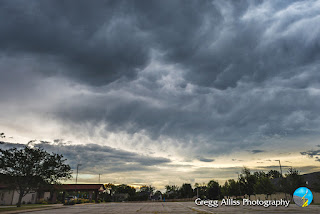Talk about a full day of weather! Storms, turning severe as they passed through Cedar Rapids, Iowa during the morning hours of Wednesday, August 3, 2022 began the busy day. Next, a spectacular cumulonimbus storm cell formed in the distant NNE sky during the mid afternoon. This storm tracked to the southeast, becoming more linear in nature and eventually arriving in Cedar Rapids just before 7:00 pm. This striking storm was accompanied by vibrant crepuscular rays and would produce yet another crepuscular arch--just my second encounter with this phenomenon--and only in a month's time! In the image above, storms approach my location at 33rd Street and 12th Street SW at 10:04 am CDT.
10:10 am. Panorama looking west.
Radarscope image corresponding to 10:10 am, showing the line of approaching storms. The blue target icon is my location.
10:11 am. Similar capture.
10:16 am. Looking northwest. This storm produced copious amounts of rain and generated 60-70 mph winds east of here. iPhone 11 camera.
10:21 am. Severe weather warning issued by the National Weather Service.
Later in the afternoon on my way home from work, my attention was diverted to a large cumulus cell on the northern horizon, distant and situated all by itself in a clear sky. The cloud continued to maintain its robust appearance along the way, and so was a potential photo opportunity. Stopping briefly at home to gather my Nikon camera, I scouted a clear northern view and soon found myself at Lowe Park in Marion, Iowa. This view looks NNE from the park at 3:32 pm.
3:35 pm. 78mm shot of the cell, showing a strong updraft toward the upper left.
3:36 pm. Similar image in panoramic form.
Radarscope image for 3:40 pm. My location in Linn County is shown by the target icon at lower left. The white arrow points to the storm, some 80 miles distant, in Allamakee County in far northeast Iowa. This system was tracking to the southeast, frequent in the summertime.
3:43 pm. Viewed from nearby Tower Terrace Road, just west of the YMCA facility in Marion. The storm cell is now fully mature and exhibits a flattening anvil top. Echo tops at this moment reached 50,000 feet. Weather conditions at this moment: 81 degrees F, 75 degree dew point, 82% humidity, wind south at 9 mph.
Weather.us Echo Tops map for 3:45 pm, showing the highest altitude (circled area) of the storm, over Lansing, Iowa.
That storm system progressed to the southeast, becoming more linear in nature. And it was tracking toward the Cedar Rapids metro area. Above, the leading edge of the advancing storm is seen in the northwest sky from Bowman Woods Park in Cedar Rapids at 6:41 pm.
Radarscope image for 6:42 pm, showing the approaching line of storms.
By 7:00 pm cloud formations were vibrant and contrasty, reflecting the setting sun. I now chose an unusual spot for photo captures: on top of our house's roof! Above, the sun peeks from behind the left side of the storm at 7:11 pm, forming the rare crepuscular arch. North (and Bowman Woods Park) is at the center of the panorama.
7:13 pm. Looking north at the storm's anvil. My Tempest Weatherflow weather station is visible at right.
Radarscope image for 7:14 pm, showing the storm cell just to my northwest.
7:16 pm. Dramatic crepuscular rays emanate from behind the storm. This was the arch's source.
7:21 pm. Terminus of crepuscular arch in the east as seen over our roof, opposite in the sky from its source. This was my second encounter ever with a rare crepuscular arch (the last one being on June 28). Either this is an incredible coincidence or I just haven't been paying close attention before! The vision seen in the image above persisted for several minutes, and in clear blue sky. Eventually clouds covered the sun in the west and the arch gradually disappeared. This crepuscular arch was more difficult to photograph in its entirety than the precious one because it was situated more overhead. My weather station recorded a total of 0.91 inches of rain from all storms this day. Nikon D7200 DSLR camera.
What an "action-packed, fun-filled day" for the weather enthuiast!
Read more...























































